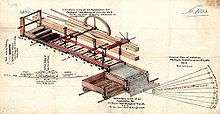Australian patent law
| Patent law |
|---|
| Overviews |
| Basic concepts |
| Patentability |
| Additional requirements |
| By region / country |
| By specific subject matter |
| See also |
|
Australian patent law is law governing the granting of a temporary monopoly on the use of an invention, in exchange for the publication and free use of the invention after a certain time. The primary piece of legislation is the Patents Act 1990 (Cth). Patents are administered by the Commonwealth Government agency IP Australia. Australia is a member state of the World Intellectual Property Organization (WIPO), and compliant with Agreement on Trade-Related Aspects of Intellectual Property Rights (TRIPS). This makes Australian patent law broadly comparable with patent law in other major countries (see Patent).
Key features
 Standard Australian Patent Procedure |
 Australian Innovation Patent Procedure |
Australia has two kinds of patent available:
- a standard patent with a term of 20 years
- an innovation patent, with a lower threshold for inventiveness, and a maximum term of 8 years.[1]
Innovation patents have a faster approval process and lower fees.
Australia operates a first to file system, like much of the rest of the world.
Australian patent databases
The AusPat Patent database[2] is the official Australian patents database operated by the Australian Intellectual Property Office. AusPat records patents dating back to 1904.[3]
History
In Australia, the system of granting patents in the Australian Colonies is based upon British law, and can be traced back to the English Statute of Monopolies of 1623. This was enacted in 1624.[4] Prior to the Colonial states enacting their own legislation in the mid-19th Century and forming their own Patent Offices, inventors applied to England for patent registration and protection.

When legislatures were established in the Australian Colonies, people could apply (petition the parliament) for a patent to be granted by the Governor of the colony, by way of a Private Bill. The first of these was South Australian Private Act No.1 of 1848, granted to Andrew John Murray of Adelaide, S.A. for "An improved windlass", on 20 June 1848, for a period of 10 years. A further three Private Acts were granted in South Australia; and several were granted in Western Australia.[5]
The first patent act in Australia, other than private acts, was introduced into New South Wales in 1852 (coming into force on 10 January 1854.)[6] Victoria proclaimed its first Patent Act in 1854, with the length of the grant being for 14 years.[7]
The administration of the States Patents Acts (NSW, Victoria, Queensland, SA, WA and Tasmania) was transferred to the Commonwealth of Australia from 1 June 1904. IP Australia is the Australian Government agency responsible for administering patents, as well as trade marks, designs and plant breeder’s rights in Australia.[7]
See also
- Patent law
- History of patent law
- Australian property law
- National Research Development Corporation v Commissioner of Patents (1959) 102 CLR 252
References
- ↑ "What is a Patent". IP Australia. Archived from the original on 12 November 2009.
- ↑ http://pericles.ipaustralia.gov.au/ols/auspat/quickSearch.do
- ↑ "AusPat About". Australian Government, IP Australia. Retrieved 10 July 2016.
- ↑ Rimmer, Brenda M.; Van Dulken, Stephen (1992). Science Reference and Information Service International guide to official industrial property publications (3rd ed.). London: British Library. pp. 7 (1.1). ISBN 0712307915. OCLC 810555503.
- ↑ Hack, Barton (1984). A history of the patent profession in colonial Australia presented at the Annual Conference of the Institute of Patent Attorneys of Australia, Brisbane, Queensland, 29 to 31 March 1984. Melbourne: Clement Hack. p. 9. ISBN 0-9590266-0-6. OCLC 27623754.
- ↑ Hack 1984, p. 10
- 1 2 "Patents Research Guide". Research Guides. State Library of Victoria. 30 September 2013.